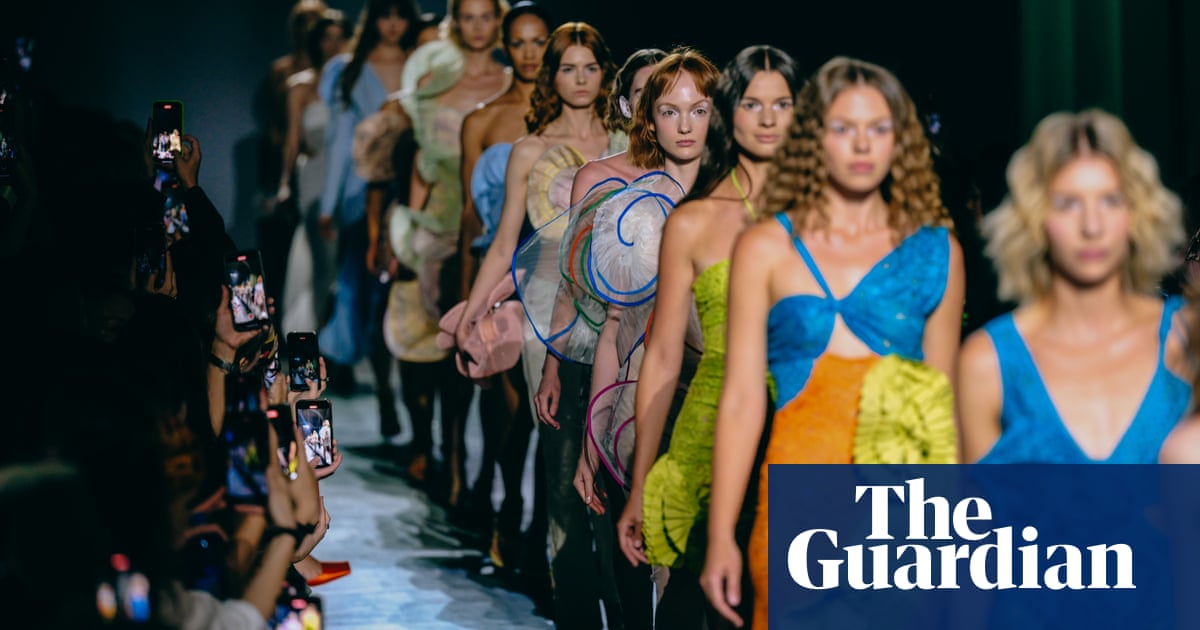The audience stood for a moment of silence to honour Ukrainian soldiers who had died in combat. Then the lights went down, the music went up, and a procession of models strutted by as the crowd snapped photos and made videos on their phones.
It is a ritual that has been repeated again and again this week in Kyiv, as Ukrainian fashion week returned for the first time since Russia’s invasion in February 2022.
As the conflict drags on, “daily life going on in the face of adversity” has become a familiar feature of Ukrainian society: opera houses and theatres have remained open since the first weeks of the invasion, Kyiv’s restaurant and bar scene is vibrant – at least until the midnight curfew approaches – and the Black Sea beaches are filled with holidaymakers in the hot summer months.
But until now, Ukrainian fashion week – previously a twice-yearly fixture in Kyiv since its launch in 1997 – had been on hold. The sight of catwalk sashays perhaps seemed a step too far, even for those in favour of keeping as much of prewar life going as possible.
That changed on Sunday, when the four-day day event began at a central venue at an exhibition centre in the heart of the city and side events at various other locations. On Monday evening, the designer Ivan Frolov took over K41, which before the war was one of the capital’s most talked-about electronic music venues, housed in a disused brewery.
Guests had stickers affixed to their phone cameras as they were ushered into the industrial space for the secretive show, which was loosely based on a Ukrainian children’s fairytale, and featured video installations, live music, fragrances and plenty of erotica alongside the viewing of Frolov’s new collection. Instagram influencers and pop stars waited to snap photographs outside, and it was a moment of pure escapism for a city that had been rudely awoken at 5.30am that morning by a massive missile barrage.
“During the second world war, the fashion industry worked – in London people got dressed up and went to restaurants. Everyone in the world should understand that life still goes on here too,” said Ruslan Baginskiy, a hat designer from the western city of Lviv, who has shot to global fame in recent years, working extensively for Beyoncé and Madonna among others.
Iryna Danylevska, the chief executive of Ukrainian fashion week, was eager to point out that fashion during wartime was not just about escapism. Many of the designers have sought their own ways to reference the circumstances in which the country finds itself. “At the beginning, we all had this euphoria and believed in a quick victory, thinking the war would finish soon. But now we learned to live with the war,” she said.
The designer Kostiantyn Omelia created a collection inspired by the dried flowers he saw when he returned to his Kyiv studio in May 2022, after leaving for three months during the early part of the war. Ksenia Schnaider created a jacket made from vintage ties – the idea being that few men have time for ties in wartime, as more dress in either military uniform or casualwear.
Even if some of the collections seem far removed from the grim world of missile strikes, trenches and combat, the war has touched the fashion industry just as it has affected almost every Ukrainian over the past years. Asked if his production had been affected by the conscription of male workers into the army, Baginskiy grew sombre: “Of course it has. The war has affected everyone. My own stepbrother was killed at the frontline,” he said.
after newsletter promotion
Danylevska said an important goal of the event was to help promote Ukrainian design and creativity globally. The Russian invasion has accelerated a cultural awakening in Ukraine, where many artists across all creative sectors are looking to previously neglected history and folklore for inspiration.
Gunia, a brand set up in 2017 by two friends bored with working in big fashion, was a frontrunner in this field. The company explores traditional Ukrainian folk themes and artisan techniques, which were “never something cool” previously, according to Maria Gavrilyuk, one of the co-founders.
The brand grew rapidly, and now has a folk-inspired clothing line as well as a large collection of whimsical ceramics and other homeware. Interest in the brand – and in Ukrainian design in general – had grown since 2022, she said.
“Previously when I travelled, I would say we were from Ukraine and nobody would know anything about it. Now, it’s the moment when the world is understanding that we have a rich culture and lots of unique techniques. It’s just a pity it took these circumstances for it to happen,” she said.











